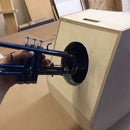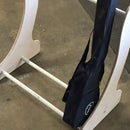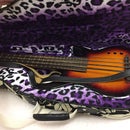Introduction: Medal Clasps Via Shapeways
The Médaille Coloniale -- the French Colonial Medal -- is a prime uniform decoration for any good 19th-century soldier. Adding some campaign clasps to a recreationist friend's medal seemed like an excellent project to test out the Shapeways workflow, from reference images to final prop.
This instructable is mostly concerned with the method(s) of working in scale from photograph to final item.
Step 1: Collecting and Collating Reference Material
My friend had already done this step for me; he determined the campaigns his character would have served in, and found appropriate images online for each of those clasps. Although the medal itself is official, campaign clasps would be run off by whatever jeweler the soldier had access to -- thus the font and border details varied widely.
Fortunately for us, however, they all hewed to a regulation size; 40 mm x 10 mm. These round numbers made working to scale much easier.
Step 2: Scaling Reference Material
Opening PhotoShop LE, I increased the canvass size of the cropped and compiled images I'd been sent, and added a grid.
The size of the grid is actually arbitrary. All I needed was a grid that contained 4 horizontal divisions the images could be scaled to. Oddly enough, setting the grid to 1 cm turned out to be that size. I then scaled the layer containing the clasps until they exactly lined up with the grid.
The last step was to crop the image at, again, a known value and at an exact square ratio. I chose to give myself 1 cm borders for ease in the modeling application; thus the final save was a square image of arbitrary pixel size that represented a 6 cm by 6 cm square in scale.
Step 3: Setting 3d Modeler Window to Scale
My current engine of choice for simple meshes is Carrarra Studio, now owned by DAZ3d. It is an inexpensive do-everything application, with decent rendering and basic mesh modeling functionality.
In Carrara, each "room" or modeler window can be set to a different working size. Any graphic you bring in as a reference to the mesh modeler will be displayed at exactly the size of the Working Box.
Thus, it was a simple matter to set Carrara to metric sizes, create a new Mesh Object, and set the working box for that object at 6 cm x 6 cm (the scale size of the reference image I created in the previous step.) I chose to set the grid to 1 cm at first to check that everything was aligning properly.
Step 4: Modeling
Making the shapes was as simple as creating a rectangle, scaling to match the reference image, and then using the edge tools to detail it. The text was done in the Text Tool, converted to mesh, and imported into the Mesh Modeler for final scaling and adjustment.
The trick for Shapeways models is the mesh must be waterproof and manifold. What this means, is every mesh must be a closed box sharing no faces with anything else. Fortunately, intersecting volumes is NOT a problem. You will be charged for intersecting volume, but as these clasps are a mere 4 cm in the largest dimension this was not a major consideration!
Each and every letter, then, had faces on the back side to make it a closed volume. The same for details like the border shown below; each "brick" had a full six faces, making it a closed volume. By setting it slightly inside the closed volume of the rest of the clasp, it would print as one single object.
This is where working in vertex mesh shines; you can check all of your surfaces and faces as you go and make sure everything is actually manifold, and thus, printable.
Step 5: Design Rules
In addition to needing to be waterproof, to be printable your mesh needs to meet the Design Rules. Shapeways has the Design Rules for all of their materials on their website. In the case of the plastics I was printing in, the essential rules were that no detail be smaller than 0.2 mm and no wall be any less than 1 mm thickness.
These clasps may be 40 mm by 10 mm, but the intricate details are pushing the limits of printability. The first version of this border I made had six of the larger divisions.
By setting the grid to .2 mm, I can visually check to see that no detail is smaller than the smallest printable dimension.
Step 6: Final Dimension Check
And here are the final models, ready to be sent off for printing. As this was an experiment, and it was also historical, they each have different border treatments. The rough surface of "Maroc" was an experiment that didn't pan out, as were the rounded-over letters of "Afrique" (neither printed usefully).
In the main window of Carrara I could check that the vertex model scaled at exactly 4 cm wide. As it turns out, however, Collada (the mesh interchange format I meant to use) does not have a global standard. My version of Carrara exported a DAZ version of Collada that Shapeways would not accept.
It turned out the best path was to export in Wavefront "obj" format, and then convert that in Hexagon (another DAZ modeling application) to .stl -- however, some peculiarity made the objects come in at about 1/2 the proper size.
Fortunately, again, I knew the model had to be exactly 4 cm wide. So I re-scaled in Hexagon, and exported in .stl with "millimeter" selected. Then used the Shapeways importer set also to mm.
The last step was to check in my basket at Shapeways, where the quote is, to see if they listed the object at 4 cm x 1 cm. After a few false starts, that is how it listed.
Step 7: Mail From the Netherlands
And this is how they come back from Shapeways. Three were printed in Black Detail, one in Strong White Flexible.
Unfortunately I couldn't wait and I had already started experimenting with finishes when I took this shot. Of course, you can't see much in black plastic.
Cost, by the way, was about eight bucks. I had to add another item to my order just to make the $25 minimum.
Step 8: Finishing
As printed, the objects have a rough surface (oddly enough, the "grain" of the surface shows up much better in photographs then it does to the eye. In real life, Shapeways objects always look smoother than they look when photographed.)
What seems to have been the method to finish these was to sand them carefully to smooth off those surfaces I could get to easily. The original rough printing surface makes a nice contrast behind the letters.
Following washing in running water and thorough drying, I applied Rub-and-Buff to the surfaces. An old paintbrush was used to remove the Rub-and-Buff where it clotted, filling up voids in letters and so forth, and to drive it down into the cracks. Once it had dried, I buffed it out with an old t-shirt.
Being in an experimental mood, I mixed the Rub-and-Buff with sepia ink to see how that worked as a different look. Eventually, I found the trick for the surfacing on "Maroc" was to wash it in diluted Pelican black ink, and then carefully brush fresh Rub-and-Buff over the shiny details.
Fixing is, at least at the moment, Blair Spray Fix.
And there you have it. "Maroc," by the way, is the White Soft Flexible. When I take the treatment I developed and apply it to the black detail printing of the same clasp, it will look nicer.













